| section Home
Production, Amateur Radio amateur Model aircraft, rocket- Useful, entertaining |
Stealth master
Electronics Physics Technologies invention |
space Mystery
Earth Mysteries Secrets of the Ocean Stealth section Map |
|
| Use of material is permitted for reference (for websites - hyperlinks) | |||
Navigation: => |
Home / Products Patents / In the section of the catalog / back / |
|
INVENTION
Russian Federation Patent RU2261362
![]()
Aerothermodynamic Windmills (ATVU)
Name of the inventor:
The name of the patentee: Miodrag Shkobal (RU)
Address for correspondence: 119313, Moscow, Leninsky Prospect, 93, building 2, kv.120, M.Shkobal
Starting date of the patent: 2003.07.10
The invention relates to the field of wind energy. The technical result is to increase the efficiency (efficiency) and reliability of wind power, simplifying the design, operation and maintenance. Aerodynamic wind power installation comprises a generator, a turbine exhaust annular wing with the inner surface of "De Laval", which is a carrier element and equipped with feathered surface carrying the radial arms, the generator cabin with a streamlined outer surface with an internal supporting structure for the generator bearings and turbine bearing, input fixed cone, radial brackets, inlet ring wing, the supporting mast swivel stand with the current collector, carrying out communication between the cabin and the reference generator mast, and the profile of the input of the ring-wing is made in tandem with the suction ring wing.
DESCRIPTION OF THE INVENTION
This invention relates to power engineering and represents a wind power installation aerothermodynamic ATVU (ATWT - AeroThermodynamic Wind Turbine), for converting kinetic wind energy, including with significant turbulent component into electrical energy. Designed for use in industrial, urban and rural public utilities, etc. (consisting of wind farms or individual units).
Known wind turbines (windmills) that convert wind energy to produce mechanical or electrical energy, which as a work item using the screw (wind wheel), Darrieus rotor, etc. A disadvantage of their design should include large dimensions, instability of dynamic loads leading to instability of electric current parameters generated, leading to the need for a special stabilizing devices.
In addition, the practice of using a large number of wind turbines in a wind farm consisting of indicates that such an installation created by the noise field is dangerous to human health because its frequency is in the infrasonic range (4-7 Hz), that environmental standards is unacceptable.
Currently known and more efficient wind power plant rotor type, technical device and essential characteristics closest to the to the present invention, which is taken as a prototype, namely RU 2124142 C1, 12.27.1998, cl. 6 F 03 D 1/04, containing a power unit mounted on a support, a nozzle apparatus and two or more turbines are mechanically connected to a generator, with a streamlined hull with wings filled with gas which density is less than the density of the atmosphere, made movable to change cross-section adjacent channels. The main drawbacks of the prototype are: construction complexity, low reliability, high cost of installation.
Technical result of the invention is to improve the efficiency (Efficiency) of the wind power installation, simple construction, high reliability, reduced noise, ease of operation and maintenance, relatively low manufacturing cost.
The technical result of the invention is achieved by using light and cheap materials, simple production technology, accessibility to rotating units, using a minimum of control automation.
Aerothermodynamic wind power plant consists of a generator mechanically connected to the turbine, the exhaust annular wing with the inner surface made on the profile of "De Laval", which is bearing element installation and equipped with feathered surface, providing orientation to the wind carrying the radial arms for fixing the generator, the cockpit generator with a streamlined outer surface and the inner supporting structure for the generator bearings and the turbine supports, the input stationary cone, closing the turbine rotor of radial arms carrying the front cone input annular wing having a closed circuit for the rotation of the turbine rotor, setting, and the rotary stand supporting masts with the current collector, carrying out communication between the cabin and the generator supporting the mast, and the profile of the input of the ring-wing is made in tandem with the suction ring wing. Wind vane surface comprises a speed sensor and a signal light, the input is a streamline cone conical surface of glass, plastic, and a turbine rotor blade made of fiberglass or polymers. The cab is connected to the generator tubular passage with a rotating stand for access to the rotating units. Support the mast is in the form of a cylindrical metal structure, reinforced concrete anchors on the foundation and having an internal staircase to the pivoting stand, cable lines and lighting.
The present invention is illustrated in the drawings.
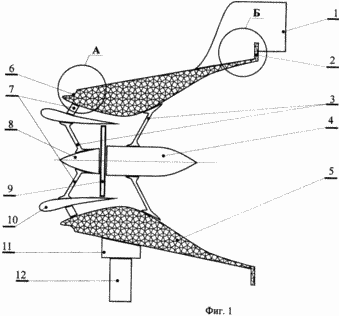 |
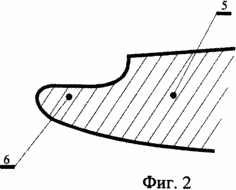 |
|||
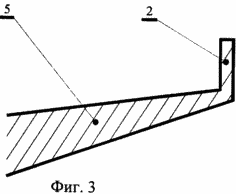 |
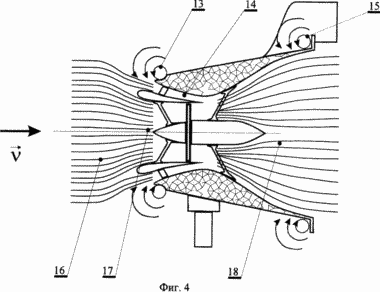 |
|||
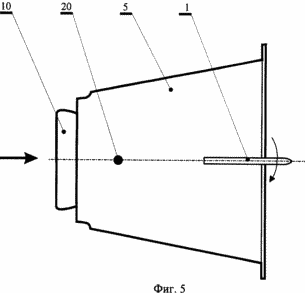 |
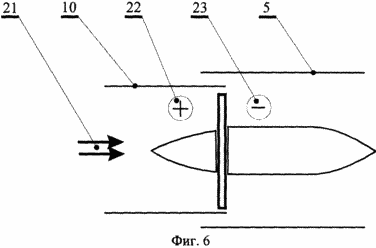 |
|||
| ||||
Aerothermodynamic wind power plant comprises an exhaust annular wing 5 with feathered surface 1, the input of the ring-wing 10, the turbine 9 is mechanically associated electric generator, enclosed in a sleek cabin 4, the stationary inlet cone 8, fixed bearing radial arms 7 to the inlet ring-wing 10 and wing suction ring 5 fastened by pivoting stand with current collectors 11 on the support mast 12.
Exhaust annular wing 5 has the following features:
- The inner surface of the exhaust annular wing 5 is the profile of "De Laval" (see Bojan Kraut. ![]() , 1988, 201). Wing Material - any slight aerodynamic cover (aluminum alloys, fiberglass, etc.) with a cell or minvatnym content.
, 1988, 201). Wing Material - any slight aerodynamic cover (aluminum alloys, fiberglass, etc.) with a cell or minvatnym content.
- Leading edge of the wing 6 exhaust ring 5 has a profile, create an input toroidal (ring) vortex of air 13, which further increases the mass air flow through the turbine 16 9.
- Along the perimeter of the trailing edge of the wing 5 exhaust ring it has an outer annular baffle hood 2 that creates an output toroidal (ring) vortex of air 15, which further accelerates the air flow 18.
Vane surface 1 provides without additional mechanisms and tools orientation setup in the wind along the rotation axis 20. The surface of the vane 1 is equipped with a sensor of wind speed, lightning device and warning light.
In the cockpit of the generator 4 with a streamlined outer surface and an inner supporting structure for mounting the turbine and the generator provides access for inspection and repair.
Radial bearing brackets 7 input annular wing 10, and a radial bearing 3 mounting brackets inlet cone 8 and the generator 4 are cabin type structural elements that are used in the aircraft industry.
Turbine inlet 9 is located inside the ring-wing 10, in its rear part, where the air flow 18 has a maximum density and speed to provide maximum efficiency
PRINCIPLE OF UNIT
The air flow 16 moving along the axis, oriented in the wind vane surface due to 1 exhaust annular wing 5, 9 reaches the turbine, causing it to rotate. Generator 4 mounted on the same axis as the turbine 9 produces an electrical current which is removed through rotary slip rings 11 stand.
To improve the efficiency of the plant has the following design features.
1. Due to the profile of the front edge of the suction ring wing 5, created in the toroidal input (ring) 13 air vortex, turbine inlet 9 creates a convergent air flow 17, whereby the mass flow of air to the turbine 9 is increased.
2. The form of the input of the ring-wing 10 and its position in the installation with an annular gap 14 allows you to repay the inlet air turbulence 19 and send it to the blades of the turbine 9.
3. The form of the inner surface of the exhaust annular wing 5, performed on a profile "De Laval", helps to create the rarefied zone in the back of the unit 18 for the turbine 9, which substantially increases the speed of the airflow at the turbine.
4. An annular baffle hood 2 produces an output toroidal (ring) air vortex 15, accelerating the speed of the airflow, creating additional negative pressure in the air flow 18 after the turbine 9.
Thanks to these design features of the proposed installation, impetuous and turbulent air flow inside the unit 19 is stabilized and in the working area of the turbine becomes laminar and the pressure increases, the maximum speed and density, which increases the efficiency of the plant and the stability of electricity generation.
THEORETICAL BASIS
Near-surface wind flows have a pronounced velocity profile depending on the height and significant turbulent component, depending on the local topography, and vegetation developments. Moving air masses have a high energy (kinetic, thermodynamic and barometric) kW / m 3 [1]
![]()
E ![]() - The total energy of the air flow [kW / m 3]
- The total energy of the air flow [kW / m 3]
To E - kinetic energy of air flow = ![]() (
( ![]() 2/2),
2/2),
E T - thermodynamic energy airflow = i (entalpiya)
E - energy barometric air flow = RT = pV.
Therefore, wind energy depends on the state of air masses [2]:

![]() - Air density,
- Air density,
![]() - Air rate
- Air rate
T - temperature,
P - barometric pressure.
Specific energy e ![]() = F (
= F ( ![]() .
. ![]() , T, p) [kW / kg].
, T, p) [kW / kg].
By applying a wind installation (turbine) can be disposed of in a complex energy contained in the wind.
Turbine assumes all transformed wind energy in the plant. In the installation, the following changes the dismal state of the wind:
1. Growth rate ![]()
![]() w turbine inlet 21 due to:
w turbine inlet 21 due to:
- Convergence of the ring-wing 10 and the reduction of the flow cross-section due to the inlet cone 8;
- Convergence ram-air intake under the action of the rotor 13.
2. Pressure Height 16 ![]() ph turbine inlet 9 by:
ph turbine inlet 9 by:
- Obstruction of air stream from the turbine disk 9;
- repayment ![]() pW vortex motion in the annular gap between the inlet 10 and annular wing inlet cone 8.
pW vortex motion in the annular gap between the inlet 10 and annular wing inlet cone 8.
3. Increased efficiency Turbine by working it in a closed loop (annular lumen) without inductive reactance.
4. For the turbine disk 9 creates a vacuum ![]() pV 23 by:
pV 23 by:
- The suction action of the air stream ![]() rV1 18;
rV1 18;
- An additional acceleration of the air stream ![]() pV2 profile "De Laval";
pV2 profile "De Laval";
- Aerodynamic generator suction action ![]() pV3 15 at the outlet of the exhaust annular wing 5, further accelerating the air flow 18;
pV3 15 at the outlet of the exhaust annular wing 5, further accelerating the air flow 18;
- The partial pressure drop of water vapor in the air due to condensation occurring at the adiabatic expansion through the turbine ![]() pV4 (ejector cooling) in the event of going beyond the condensation.
pV4 (ejector cooling) in the event of going beyond the condensation.
5. The emergence of the aerodynamic moment, orienting the installation of the wind on the surface:
- Frontal section of the input of the ring-wing 10 + MI;
- The outer surface of the exhaust annular wing 5 - MII;
- Feathered surface 1 - MIII.
Wherein:
M M II + III> M I (the opposite direction of action - is balanced)
M = f ( ![]() ), With
), With ![]() = 0 ° the state of equilibrium, and aerodynamic moments are absent.
= 0 ° the state of equilibrium, and aerodynamic moments are absent.
- Strength, realized on the turbine [3]:
![]()
![]() p h - additional pressure of the incoming flow to the turbine disk,
p h - additional pressure of the incoming flow to the turbine disk,
![]() p v - additional vacuum airflow for the turbine disk,
p v - additional vacuum airflow for the turbine disk,
A [n 2] - Input sectional surface of the annular wing,
![]() - wind speed,
- wind speed,
![]() p h [N / m 2] - setting function design,
p h [N / m 2] - setting function design,
![]() p v [N / m 2] - setting function design,
p v [N / m 2] - setting function design,
![]() - Efficiency,
- Efficiency,
![]() ATWT [%] significantly higher>
ATWT [%] significantly higher> ![]() VEU classical helical wind turbine due to synergistic action:
VEU classical helical wind turbine due to synergistic action:
- Convergence of the air flow;
- Repayment of turbulent flows;
- Increasing the volume of incoming air;
- Actions of the front aerodynamic generator;
- Rear aerodynamic generator action;
- Operation of the turbine in a closed loop;
- compound ![]() pV due to the partial pressure of water vapor;
pV due to the partial pressure of water vapor;
- An ejector (pulling) the effect of the reverse side of the turbine;
- It has a higher turbine efficiency than the screw.
Since the general ![]() ATWT [%] is a function of the installation of the wind speed acting on the installation
ATWT [%] is a function of the installation of the wind speed acting on the installation ![]() then indeed [4]:
then indeed [4]:
![]()
or
![]()
where wind turbines - a classic screw-type wind power plant. According to the classical aerodynamic calculations in the field of conventional wind 4 ÷ 6 [m / s]:
![]()
that by itself proves the advantage of installing wind turbines in front of the classic screw-type.
Installation is subject to wind loads at a given height, which is determined by the distance from the axis of rotation of the turbine soil horizon on which an installation built. Since the installation is able to extinguish and dispose of the turbulence of wind flows, she installation height is not very demanding, and its diameter is smaller rotation causes this. The only requirements for the installation height - so that it has sufficient access to the intensive air jet, without requiring that those flows are laminar.
Due to the special profile 6 front edge of the suction ring wing 5, create an input toroidal vortex of air 13, the turbine inlet 9 formed convergent oncoming wind stream 21, thereby increasing the mass air flow that differentiates the system from the classical installations screw type [7]
![]()
D i - the diameter of the anterior (front) part of the exhaust annular wing,
![]() - Air density,
- Air density,
K to - convergence factor wind jet:
To K = f (V w); K> 1 (see. [6]).
Increased mass air flow 17 is utilized in the turbine exhaust through 9 (ejector) Action exhaust annular wing 5. Increased mass airflow increases the energy-conversion efficiency, but also provides a pressure increase 22 to drive the turbine 9.
The air stream in the annular space between the two annular profiles 14 speeds and drive the turbine 9 creates a vacuum zone 23, creating additional torque to the turbine shaft and the increased absorption (converged) air flow 17 entering the inlet annular wing 10. Thus, a flow of air the flow through the turbine without the turbulent eddies impeding airflow, and then ![]() p h [2] = max, that maximizes the turbine load.
p h [2] = max, that maximizes the turbine load.
The outgoing air jet initially accelerated in the annular space 14, and then continues to accelerate due to the internal profile of the exhaust annular wing 5 (De Laval), smoothing the turbulence and enhancing the entire mass flow through the turbine 9, and then ![]() p h [2] = max, that maximizes the turbine load.
p h [2] = max, that maximizes the turbine load.
Acceleration of the effluent is still further increased by the action of an external ring around the perimeter of the visor 2 exhaust outlet of the annular edge of the wing 5 that generates an output toroidal vortex 15.
Presented installation has significant advantages over known analogs, since it is much more efficient converts the wind flow kinetic energy into electrical energy and does not require a mechanism for rotating the wind. In addition, the installation of the wind turbine is different from other simple design, as the most technologically complicated knot design is performed on the profile of "De Laval" inner surface of the exhaust annular wing.
1. Installation utilizes all components of the wind energy (thermodynamics of the moving mass of the gas mixture).
2. Installation is much faster at the entrance to the turbine area of the incoming air flow, increases the kinetic energy of its component creates an optimal mode of operation for the turbine and generates infrasound.
3. Installation creates a low pressure (vacuum) of the turbine disc and thereby increases the pressure difference, which is realized on the turbine.
4. Installation creates dismal convergence of air flow, thus increasing the air mass flow (and realized energy to the turbine) through the installation.
5. Installation itself is oriented to the wind vane surface due to the exhaust of the ring-wing.
6. The installation of adiabatic expansion of the air flow passing through the turbine creates a temperature difference ( ![]() tT), which further enhances vacuum for drive turbines, which leads to additional condensation of atmospheric moisture, which can collect.
tT), which further enhances vacuum for drive turbines, which leads to additional condensation of atmospheric moisture, which can collect.
7. The device provides a high enough speed at the turbine that allows the use of low-speed asynchronous generators without gears (multipliers).
8. Installation as compared to other wind turbine is a low noise source because all noise sources closed volumetric body; and infrasound component is absent.
9. Install efficiently utilizes the energy of turbulence and gusts of wind, which makes it applicable in geographical areas with difficult topography. Thus, the installation is not very demanding on the height of its installation.
10. Installation of different technological simplicity of design (for performance, for use, for installation and repair) with the simplest electronic automation.
11. Due to the acceleration of the air stream at the input unit has a lower threshold for inclusion (already produces electricity with minimum wind speeds), as compared with similar turbines.
12. The proposed installation of comparative disadvantages, as such, does not have and is only an improvement of parameters and characteristics of the existing wind turbines.
13. Installation is more compatible with the ecological environment than other currently existing wind turbines.
INFORMATION SOURCES
1. Willy JG ![]() Flugzeugtriebwerke;
Flugzeugtriebwerke;
2. Erich Hau, Windkraftanlagen;
3. Eckhard Rebhan (Hrsg.), Energiehandbuch;
4. Hutte, Die Grundlagen der Ingenierwissenschaften;
5. Horst Crome, Handbuch Windenergie Technik;
6. Robert Y. Redlinger, Per Dannemand Andersen , Poul Erik Morthorst, Wind Energy in the 21 st Century;
7. Tony Burton, David Sharpe, Nick Jenkins, Ervin Bossanyi, Wind Energy Handbook;
8. T.E.Faber, Fluid dynamics for physicists;
9. European Wind Atlas, Copyright © 1989 by Rise National Laboratory;
10. Bojan Kraut ![]() Kniga, Zagreb, 1988.
Kniga, Zagreb, 1988.
CLAIM
1. Aerodynamic wind power plant comprising a generator, a turbine exhaust ring wing with the inner surface made in the profile "de Laval", which is a supporting member installation surface and equipped with vanes, provides orientation to the wind, the radial bearing mounting brackets oscillator generator cab a streamlined outer surface and the inner supporting structure for the generator bearings and the turbine bearing, the input fixed cone, closing the turbine rotor radial arms that carry the input cone inlet annular wing having a closed circuit for the rotation of the turbine rotor, the supporting mast installation and the rotary stand with current collectors, carrying out communication between the cabin and the generator supporting the mast, and the profile of the input of the ring-wing is made in tandem with the suction ring wing.
2. Apparatus according to claim 1, wherein the vane comprises a surface wind speed sensor and a signal light, the input is a streamline cone conical surface of fiberglass, and the turbine rotor blades are made of fiberglass or polymers.
3. Apparatus according to claim 1, characterized in that the cabin passage tube generator connected to the rotary stand for accessing rotating assemblies.
4. Apparatus according to claim 1, characterized in that the supporting mast is in the form of a cylindrical metal structure, fastened to the concrete foundation and the anchors having an inner staircase to swivel stand, cable lines and lighting.
print version
Publication date 30.01.2007gg



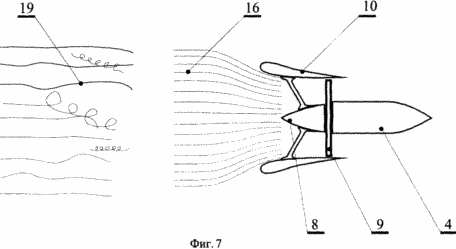
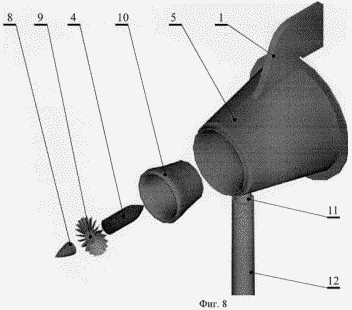

Comments
Commenting, keep in mind that the content and the tone of your messages can hurt the feelings of real people, show respect and tolerance to his interlocutors, even if you do not share their opinion, your behavior in terms of freedom of speech and anonymity offered by the Internet, is changing not only virtual, but real world. All comments are hidden from the index, spam control.